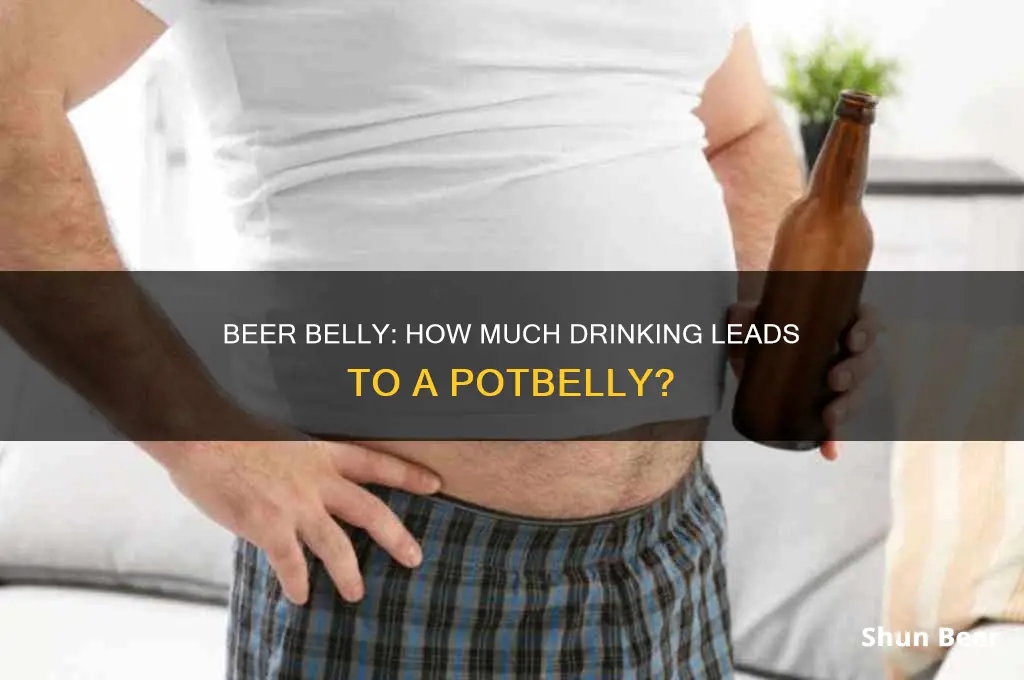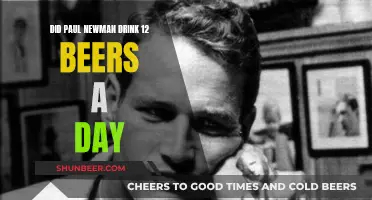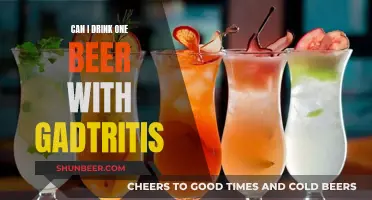
The term beer belly is often used to describe a protruding belly that extends over one's pants. While beer drinkers are frequently associated with this phenomenon, not all beer drinkers have beer bellies, and some teetotalers do. The main cause of a beer belly is consuming too many calories, which can come from alcohol, sugary drinks, oversized portions of food, or other sources. Beer is often blamed for causing beer bellies because it is high in calories and easy to overconsume, with a typical beer containing 150 calories. Additionally, alcohol interferes with the body's ability to burn fat, as the liver prioritizes breaking down alcohol over burning fat.
| Characteristics | Values |
|---|---|
| Number of beers to drink per day | More than 1 beer per day or regular binge drinking |
| Alcohol content | The more alcohol content, the more calories |
| Calories | Beer contains as many calories as soft drinks |
| Appetite | Alcohol increases appetite in the short term |
| Fat burning | Alcohol prevents the body from burning fat |
| Phytoestrogen | Beer contains phytoestrogens that may increase the risk of storing belly fat |
| Gender | Men are more likely to develop beer bellies than women |
| Testosterone | Alcohol lowers testosterone levels, increasing the risk of belly fat |
| Binge drinking | Drinking more than four drinks at one time can increase the risk of belly fat |
| Exercise | Aerobic exercises like running, swimming, cycling, and tennis help reduce body fat |
What You'll Learn

Alcohol calories and belly fat
Alcoholic drinks are often referred to as a source of "empty" calories. This means that they provide your body with calories but contain very few nutrients. A typical beer has 150 calories, and a night out with several drinks can lead to consuming a few hundred extra calories.
When you drink alcohol, your body prioritises breaking it down over other sources of fuel, including stored fat. This means that drinking alcohol can prevent your body from burning fat. In addition, alcohol can increase your appetite, leading to excess calorie consumption.
The link between alcohol consumption and belly fat is particularly strong in men. This is partly because men tend to drink more heavily than women and are more likely to drink beer, which is higher in calories than many other alcoholic drinks. In addition, alcohol can lower testosterone levels, which can increase the risk of weight gain, especially around the belly.
Studies have also shown that heavy drinking can lead to weight gain over time. The National Institute on Alcohol Abuse and Alcoholism (NIAAA) defines heavy drinking as more than three drinks per day or seven drinks per week for women, and more than four drinks per day or 14 drinks per week for men.
To minimise the risk of weight gain, it is recommended to keep alcohol intake within these guidelines and lead a healthy, active lifestyle. Light beers with 100 calories or less are a better option than regular beers, and it is also a good idea to drink alcohol only on weekends and to alternate alcoholic drinks with low-calorie, non-alcoholic beverages.
Parking Lot Beer: Is It Legal to Drink?
You may want to see also

Beer calories
The high calorie content of beer is due to the sugar extracted from barley and grains during the fermentation process. The more sugar present, the higher the alcohol content and the greater the number of calories. Beer is also often consumed with calorie-dense foods such as pizza, wings, and other fried foods, further increasing overall calorie intake.
In addition to excess calorie consumption, beer may also contribute to weight gain by preventing the body from burning fat. Alcohol is prioritised by the body for breakdown over other fuel sources, including stored fat. This can lead to an increase in body fat over time, particularly if consumed in large quantities or through binge drinking.
Beer also contains phytoestrogens, plant compounds found in the flowers of the hop plant used for flavouring. These phytoestrogens can mimic the female sex hormone estrogen and may cause hormonal changes in men that increase the risk of storing belly fat. However, the exact impact of phytoestrogens on weight and belly fat is not yet fully understood.
To minimise the risk of weight gain and belly fat, it is recommended to limit alcohol intake, practise a healthy and active lifestyle, and make informed choices when consuming beer. Light beers with 100 calories or less, low-calorie options, or opting for smaller servings of higher-ABV beers can help reduce overall calorie intake.
Beer and Zoloft: Is It Safe to Drink Alcohol?
You may want to see also

Alcohol's effect on testosterone
The link between alcohol consumption and testosterone levels has been studied extensively, and while there is some conflicting evidence, a general consensus has emerged. Occasional and light to moderate drinking may cause a slight increase in testosterone production. However, heavier and more frequent alcohol consumption can lead to a decrease in testosterone levels. This effect is more pronounced in chronic heavy drinkers, who are more likely to experience long-term damage to their testicular function and lower testosterone levels.
The mechanism behind alcohol's impact on testosterone involves the disruption of three glands necessary for testosterone production: the hypothalamus, anterior pituitary gland, and the testes. Alcohol can interfere with the release of hormones from these glands, leading to impaired testosterone synthesis. Additionally, chronic alcohol misuse may damage the Leydig cells in the testes, which are responsible for testosterone production.
Genetics also plays a role in the relationship between alcohol and testosterone. A 2022 study on Korean men found that heavy drinkers who experienced facial flushing when consuming alcohol had lower testosterone levels than non-drinkers. This flushing reaction is genetically linked and is more common in East Asian populations. The study suggests that the accumulation of acetaldehyde, a byproduct of alcohol metabolism, may be responsible for the decreased testosterone levels in this group.
It's worth noting that the effect of alcohol on testosterone may be reversible to some extent. Quitting alcohol or reducing intake can help reverse the damage to the brain and testes caused by chronic drinking. However, recovery can take months or years, and some damage may be permanent.
In summary, while light to moderate alcohol consumption may not significantly impact testosterone levels, chronic heavy drinking can lead to decreased testosterone production and various associated health issues. The relationship is further influenced by genetic factors, such as the flushing reaction observed in some individuals.
Strategies to Help Your Husband Stop Drinking Beer
You may want to see also

The role of phytoestrogens
It is important to note that beer consumption can lead to weight gain, including belly fat, when exceeding one beer per day or regularly binge drinking. This is due to the high number of calories in beer, its potential to increase appetite, and its ability to prevent the body from burning fat. Additionally, beer contains phytoestrogens, which are plant compounds that can mimic the female sex hormone estrogen in the body.
However, in 1999, a potent phytoestrogen called 8-prenylnaringenin was discovered in hops, which is 50 times more potent than the phytoestrogen found in soy. This discovery provided an explanation for the menstrual disturbances experienced by female hop workers in the past. While modern harvesting methods have reduced direct exposure to hops, the compound can still be consumed through beer.
The potential health impact of 8-prenylnaringenin in beer has been a topic of discussion. Studies in mice suggested that another phytoestrogen in hops, called isoxanthohumol, could be converted by the liver into 8-prenylnaringenin, enhancing the estrogenic effect. However, studies using human estrogen receptors did not find evidence of this conversion in the liver.
Further research revealed that the human colon, with its diverse microorganisms, could also convert isoxanthohumol into 8-prenylnaringenin, increasing the exposure to this potent phytoestrogen. This could explain the detection of 8-prenylnaringenin in the urine of beer drinkers for several days. While the amount of 8-prenylnaringenin in beer is not a significant concern, the potential for conversion by the intestinal microbial community raises questions about possible estrogenic effects.
In conclusion, while beer consumption can contribute to weight gain and belly fat through excess calories, the role of phytoestrogens in beer belly formation is less clear. The discovery of 8-prenylnaringenin in hops and its potential conversion in the human body adds a layer of complexity to the understanding of beer's impact on hormone levels. While studies have not confirmed a direct link between beer and estrogenic effects, the presence of phytoestrogens in beer remains an area of ongoing investigation.
Beer and ProctorU: What You Need to Know
You may want to see also

How to get rid of a beer belly
The beer belly is a well-known phenomenon, but it's not just beer that causes it. Alcohol consumption, particularly in men, is linked to abdominal obesity, or the 'beer belly'. The high-calorie content of alcohol is the main culprit, with almost as many calories per gram as pure fat. This, combined with the fact that alcohol increases your appetite, can lead to weight gain all over the body.
So, how do you get rid of a beer belly?
The best way to get rid of a beer belly is through a combination of diet, exercise, and reducing your alcohol intake. Here are some tips to help you get started:
- Reduce your alcohol consumption: Stick to the UK Chief Medical Officers' (CMO) low-risk drinking guidelines of not regularly drinking more than 14 units a week. This is about six pints of typical-strength lager or five 175ml glasses of wine in total.
- Have more drink-free days: Taking days off from drinking can help cut down on calories and contribute to weight loss.
- Opt for low-alcohol or alcohol-free drinks: Swapping an alcoholic drink for a low-alcohol or alcohol-free option can help reduce your calorie intake.
- Don't drink the night before exercising: Drinking can get in the way of your exercise routine, so it's best to avoid it the night before.
- Eat a healthy, reduced-calorie diet: Focus on eating more vegetables, fruits, whole grains, and lean proteins. Cut down on processed foods, foods containing added sugars, enriched flour, and saturated fats.
- Make healthy food swaps: Try strawberries instead of ice cream for dessert, or water flavoured with lemon or lime instead of soda. Use healthier fats, such as olive oil, instead of butter when cooking.
- Increase your physical activity: Try high-intensity interval exercise (HIIE), which involves short bursts of intense activity followed by brief rest periods. Aim for at least 30 minutes of moderate-intensity aerobic exercise most days of the week, as well as strength training and stretching.
- Make lifestyle choices that burn more calories: Take the stairs instead of the elevator, or take frequent breaks at work to take short walks.
It's important to note that getting rid of a beer belly may take longer than it did to put on the weight. Be patient and consistent with your healthy diet and exercise routine, and remember that reducing your alcohol intake is crucial to losing that beer belly.
Gluten Sensitivity and Beer: What's Safe to Drink?
You may want to see also
Frequently asked questions
There is no specific amount of beer that will guarantee a beer belly, but the more you drink, the higher the chance of developing one. Drinking more than one beer a day or regularly binge drinking increases your risk of belly fat gain and other health problems.
Beer is high in calories and can lead to excess calorie consumption, preventing your body from burning fat. It also contains phytoestrogens, which may cause hormonal changes that increase the risk of storing belly fat.
Men are more likely to develop a beer belly due to differences in metabolism and hormone levels. Men tend to store fat around their bellies when they gain weight, while women tend to store fat in their arms, thighs, and buttocks.
To get rid of a beer belly, you need to reduce your overall body weight through a combination of diet and exercise. Cut back on your beer consumption, eat healthier foods, and increase your physical activity.







